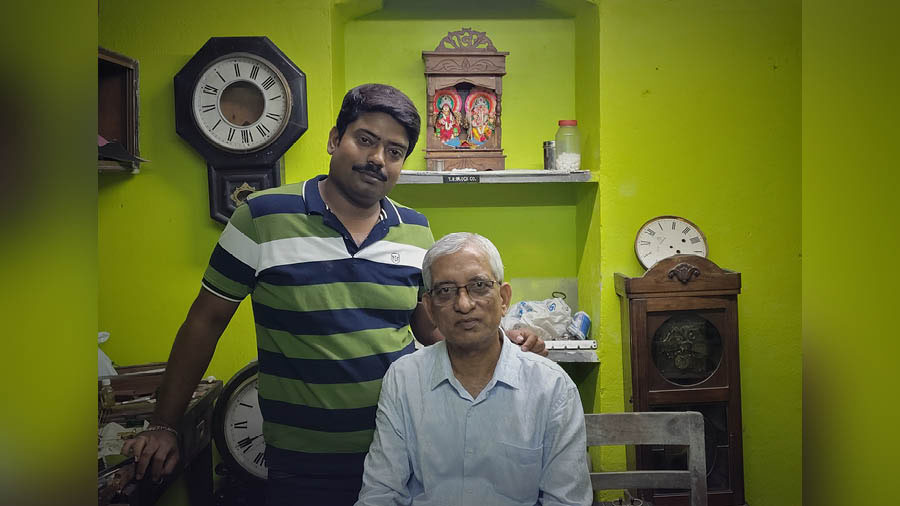Madan Gopal Lane can, at times, feel hard to find. The alley facing Calcutta Medical College’s Gate No. 2 is thin and inconspicuous, barely visible to the searching eye. Thankfully, Swapan Dutta comes to the rescue with directions that prove impeccable. Sonotime, Dutta’s one-room workshop, seems tiny, especially when one thinks of the giant tower clocks he is used to repairing. The air regularly breaks into chimes. A broken cuckoo clock seems back in business. Dutta, you can tell, is a master of his trade.
“This is work my family has been doing for five generations,” says Dutta, looking discernibly proud. His great grandfather, Dharani Dhar Dutta, he tells us, was the first to try his hand at installing and repairing large clocks: “In those days, the clocks would be bought from companies like Cooke and Kelvey, and Hamilton. He would either fit these in public spaces or maintain those that were in people’s homes.” Dutta’s elder son, Satyajit, has been listening in. He quickly jumps in to add, “I’ve heard that kings and princes would all send their personal horse carriages to fetch him. He was renowned for his expertise.”

Swapan and Satyajit Dutta outside Sonotime, their workshop in Kolkata’s Madan Gopal Lane Shreevatsa Nevatia
Both Dutta, 75, and Satyajit, 43, it soon becomes clear, have treated this inherited “expertise” more as craft and less as utility or tool. “I continued doing the work my father and forefathers had done because I loved it, and I think my son does it for the same reasons.” Satyajit says he grew up in a home that was filled to the brim with clocks of all kinds, everything from grandfather to wall clocks. “My father would work on them and I would play with them. I soon wanted to know which part fits where. That is how it all began.” For Satyajit, his integration into the family business felt seamless. He and his father now share a quiet camaraderie. They are both in the habit of finishing each other’s thoughts and sentences.
“This work is hard to do if you don’t enjoy it, or aren’t interested in it,” Dutta reiterates. Dutta’s younger son, Surajit, for instance, eventually chose a different profession, but in 1988, when registering his vocation as a business, the clock engineer says he had both his children on his mind: “I chose the name T. R. Clock Company because Satyajit’s daak naam is ‘Tinka’, and we’re all used to calling Surajit ‘Raja’.”
Since its inception, T. R. Clock Company has installed or maintained several clocks Kolkata today thinks of as ‘iconic’ — the clock tower at the Kidderpore Dock, the clock beneath Metropolitan Building’s bright golden dome on Chowringhee, and the Lake Town Clock Tower, all owe a certain debt to the skills of either Dutta or Satyajit. Bringing out his phone, Satyajit shows us a picture of him holding the hands that now meet every hour on the Lake Town Clock Tower, Kolkata’s answer to London’s Big Ben. The minute hand is twice as tall as Satyajit. “No dial in Kolkata is bigger than the one we fit in Lake Town.”
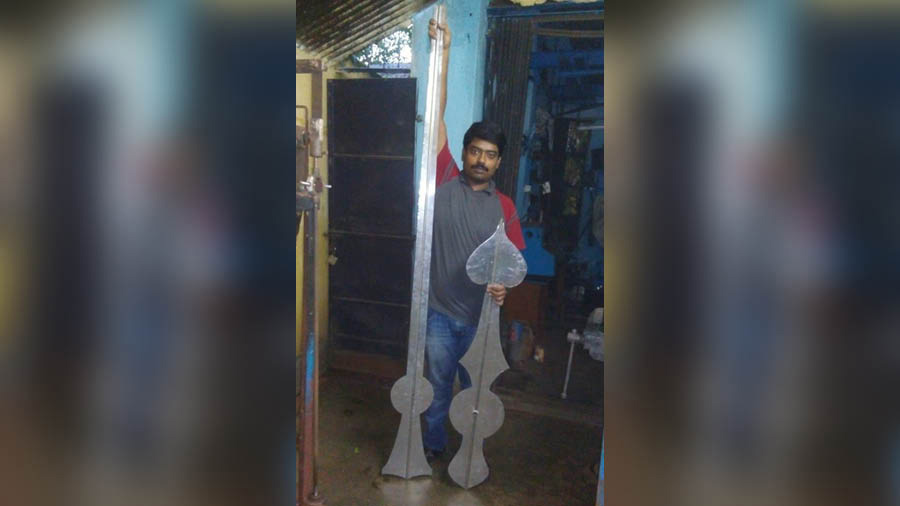
Satyajit Dutta stands with the two large hands that were finally installed on the dial of the Lake Town Clock Tower Satyajit Dutta
Dutta then points our attention to Kidderpore’s clock tower. “Many foreigners come there because it is such an important port, and we feel proud because such an old clock is still showing people and tourists the right time.” Satyajit is sure to drive his father’s point home: “That may even be a subconscious thought, but our hope is it that it will strike you sometime. This is how we represent India to the world.”
A stitch or two in time
In a city where the flow of time isn’t always smooth, where a seemingly crippled past sometimes struggles to keep up with a fast-forwarding present, Dutta makes a striking claim. Chances are that his family has, at some point or another, fixed most of Kolkata’s large clocks, “especially those that are over a hundred years old”. Not only have the Duttas repaired Abanindranath Tagore’s old clocks, they have also worked with the Pathuriagatha branch of the Tagore family. “My father knew Prodyot Coomar Tagore, and I have worked closely with his future generations. For years, we looked after the clock you see at the Tagore Castle. We also did a lot of work in the homes of Chitpur’s many zamindars.”
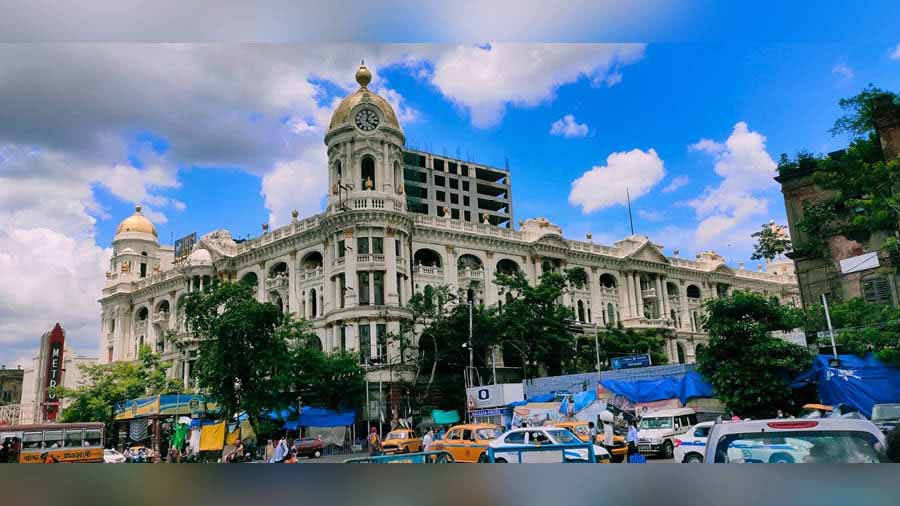
Swapan and Satyajit Dutta help maintain the clock beneath Metropolitan Building’s bright golden dome on Chowringhee Satyajit Dutta
Dutta remembers starting work with his father, Patit Paban, when he was just “15 or 16”. When taken to St. Paul’s Cathedral and St. John’s Church, some people would look at him and say, “What can this child possibly do?”, but there were others who would cheer him on: “Thanks to this encouragement, I learnt how to make my work extraordinary. Soon, everyone started trusting me with their expensive chiming and moon face clocks. All the clients started giving me tea. They would fondly call me ‘Bachu’.”
Leaning closer, Dutta whispers to us a secret he hasn’t yet found the courage to tell Satyajit. A few days ago, Dutta received a sudden call. A priest from the Sacred Heart Church was ringing. “The Father sounded troubled because the clock outside the church’s spire has not been working well. My family doesn’t know this, but only this morning I went there to check the workings of its clock.” Dutta says he chose to make this trek because he feels duty-bound to his city — “Sacred Heart has a unique address, 3 Lenin Sarani Road; it’s right on the Dharmatala crossing, a prime location!” — but also because he feels a love for the church and its priests that is hard to explain. Dutta’s diagnosis was quick and honest. “The machines of the clock were being impacted by the sand that was falling on them from on top,” says Dutta. “I told Father that before he thinks of repairing the clock, he should get the roof fixed first.”
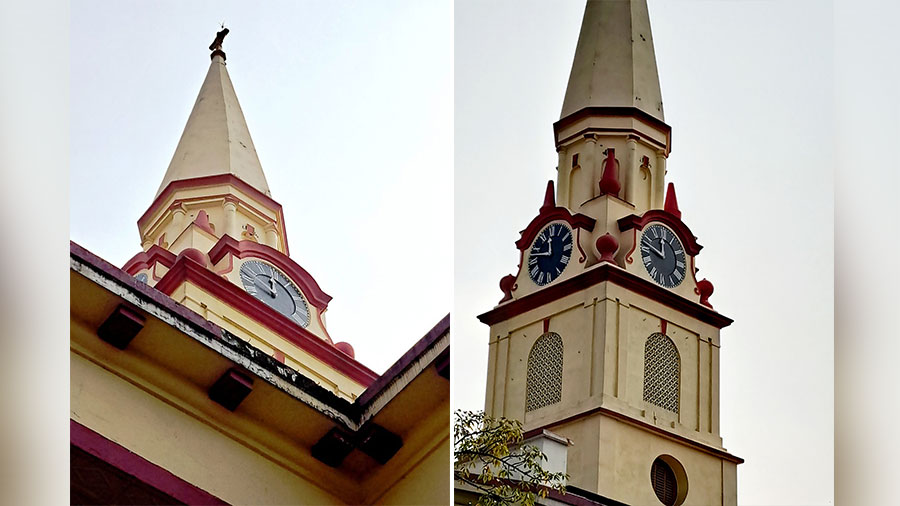
The clock tower of the Sacred Heart Church Somen Sengupta
Though Satyajit is aware that church administrators do not always have the funds to meet costs, his displeasure stems more from concern. “I don’t care if my father’s morning expedition was profitable or not. He is 75. Many of the wooden steps at Sacred Heart are broken. He should not be making these trips alone.” Dutta’s persistent smile finally seems to disarm Satyajit. After a pause, he adds, “But I know why Baba did it. Sometimes you fall helplessly in love with clocks and buildings. I feel that myself.”
The Basilica of the Holy Rosary in Bandel, or ‘Bandel Church’ as it is more popularly known, is today identified by the clock you see on its tower. “Most people now think it’s been there for centuries, but that’s not the case,” says Satyajit. “It was Baba who had installed it there in 1990. Clocks just have this way. They always know how to become a part of history.” Satyajit then speaks of the Indian Institute of Engineering Science and Technology in Shibpur (formerly known as the Bengal Engineering College): “That college’s logo is now an image of their clock tower that we maintain. It is a strange attachment.”
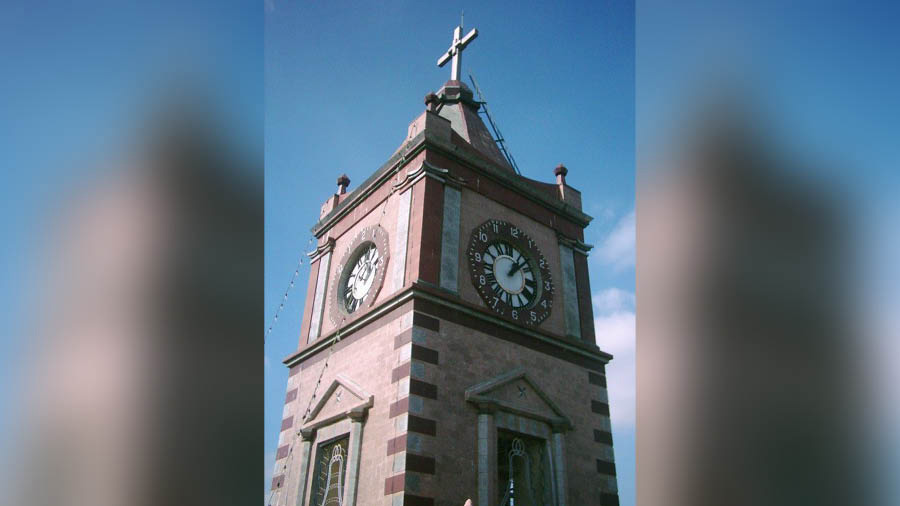
The Basilica of the Holy Rosary in Bandel, or ‘Bandel Church’ as it is more popularly known, is today identified by the clock you see on its tower. ‘Most people now think it’s been there for centuries, but that’s not the case. It was Baba who had installed it there in 1990,’ says Satyajit @subhadipin/FreeImages
From time stamps to time travel
It isn’t just Bengal where Dutta and Satyajit have left the stamp of their craftsmanship. Up until a few years ago, Dutta would tour the country every three or four months. “I’d start in Shimla. There’s a clock outside the BSNL building that we restored. From there, I would go to Punjab’s Kapurthala, and then to Haridwar. The famous Har Ki Pauri clock there has for long been our responsibility.” Dutta says he would invariably wrap his travels in Delhi. “We’ve looked after the clock you see at the Shri Ram College of Commerce, and I’d also go there to do work for business families, many of who I knew from Kolkata.”
After Dutta stopped travelling because of ill-health last year, Satyajit began to make these trips alone. Like his father, he, too, remains tight-lipped about their private clients. “They mostly like to remain anonymous,” he tells us. “But there was once a time,” adds Dutta, “when many of their companies were headquartered here in Kolkata. When they were leaving, many proprietors took with them the big, old clocks they would keep in their bungalows or mansions.” Satyajit recalls seeing a particular clock in a Kolkata home that he reckons far exceeds the famed musical clocks that have been collected in Hyderabad’s Salar Jung Museum: “It was here that I had seen a clock with thirteen dials. It would track everything — leap years, dates, everything — but it was special for another reason. Every hour, you would see the top of the clock transform into a revolving Durga Puja procession. Instead of chimes, you’d hear the dhak and the kartal. It was an astonishing sight. That clock has now been taken to Delhi.”
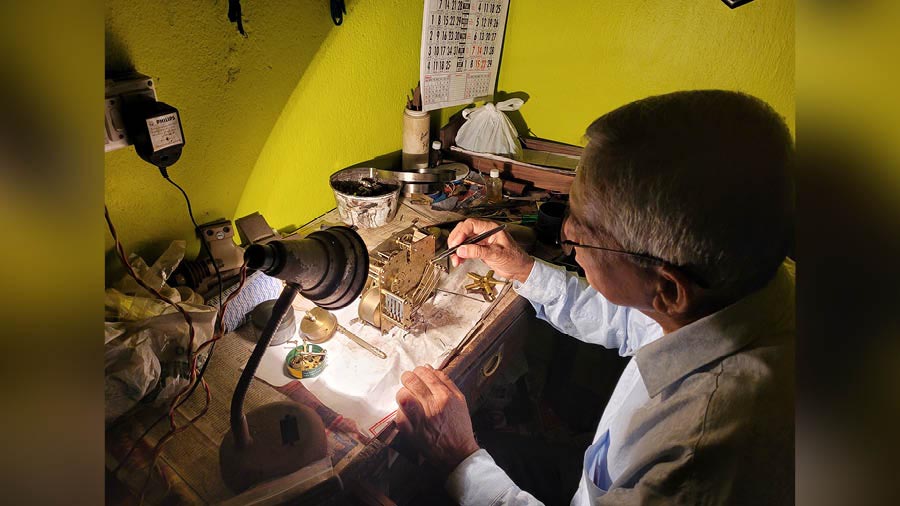
Swapan Dutta repairs a clock part in his one-room workshop Shreevatsa Nevatia
According to Dutta, a few Kolkata families still possess some uncommon antique clocks, “but not all of them are being repaired and maintained well”. The father and son say they both feel their heartstrings tug each time they think of the clock tower in New Market. “For me, it is Kolkata’s most iconic clock,” says Satyajit. “It would be hard to find another tower clock like that in all of India. It is a quarter-chiming tower clock. It plays music every fifteen minutes. Such clocks are very rare.” Though Dutta was tasked with its maintenance for several years, he says his services have not been called upon since the clock fell into disrepair in 2018. “Its sound has no parallel,” he says. “I feel terrible that it hasn’t been fixed.”
For Dutta, today’s youth can broadly be divided into two distinct categories: “Some young people I meet are not very interested in their heritage and there are others who are madly passionate about it.” Satyajit adds that many of the grandfather clocks youngsters want to save today were all, perhaps, literally installed by their grandfathers and maintained by their fathers. “For those who have such sentimental attachments, these clocks are all very precious. They want to save them at whatever cost.”

An inside view of the clock tower Swapan and Satyajit Dutta made functional near Kolkata’s Karunamoyee bus station Satyajit Dutta
Satyajit tells us the story of a young customer who recently brought him some mishti. “This man had taken his grandfather’s clock to a few other places, but none of them were able to help him. Even though we do not claim that we can fix all problems, we like to meet the hardest of challenges with a positive attitude. That’s what we did in this case, too. The client was so pleased with the outcome, he keeps calling to say that the clock is working very well, or that he is calling his friends home to see it.”
Such enthusiasm is so contagious, feels Satyajit, that he sometimes wishes he could pass it on to his daughter: “So many of the clocks that I work on today have either been installed or maintained by my father and forefathers. I want my daughter to feel the same pride I do. I know she is only 10, but she is fascinated by the cuckoo clocks I bring home. I want this interest to build. I know that’s how I started.”
